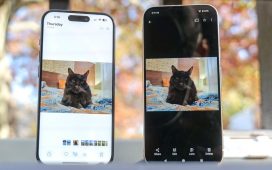Apple’s recent rollout introduces the iPhone Stolen Device Protection feature, enhancing security for iPhone users. This innovative tool is designed to significantly limit the access a thief can gain, even if they have possession of your phone and its passcode.
The Stolen Device Protection function implements additional security layers, safeguarding your iPhone when unauthorized attempts are made to access or alter sensitive settings. For example, if an unauthorized user tries to retrieve passwords from Apple’s keychain, the system blocks access unless verification through fingerprint scanning or face recognition is provided, confirming the user as the rightful owner.

What is iPhone Stolen Device Protection?
Apple’s iPhone Stolen Device Protection is a robust security feature integrated into iOS 17.3, aimed at safeguarding your personal information and accounts in the event of theft. This feature activates additional security protocols when your iPhone is away from familiar locations like your home or workplace.
Key features of Stolen Device Protection:
- Enhanced security in unfamiliar locations: When your iPhone is not in a familiar location, Stolen Device Protection imposes extra security requirements for certain actions, preventing unauthorized changes to your account or device by someone who knows your passcode.
- Biometric authentication: Accessing stored passwords and credit cards requires Face ID or Touch ID authentication, with no passcode alternative. This ensures that only the legitimate owner can access these sensitive features.
- Security delay: Critical actions like changing your Apple ID password invoke a security delay. This involves waiting for an hour and then re-authenticating via Face ID or Touch ID, thwarting immediate unauthorized changes by a thief.
- Normal operations in familiar locations: In locations like your home or workplace, where the iPhone is used regularly, these additional security steps are bypassed, allowing normal use with the device passcode.
- Additional limits in unfamiliar settings: If someone unlocks your phone in an unfamiliar location and attempts to change certain settings, they must use Face ID or Touch ID. This includes actions like disabling Lost Mode, erasing the phone, or making financial transactions.
- Two-tier security checks: For extremely sensitive information, Apple imposes a one-hour “security delay” after biometric verification. During this period, the phone remains accessible, but critical settings changes require a second biometric check after the delay.
- Protection against rapid unauthorized changes: The delay mechanism is crucial for preventing a thief from quickly altering settings like Apple ID password, Face ID or Touch ID accounts, and Find My tool.
Enabling this feature enhances data protection and can significantly disrupt thieves’ attempts to access or alter your iPhone. It is highly recommended to activate this feature for an added layer of security.

How to activate iPhone Stolen Device Protection?
To activate the iPhone Stolen Device Protection, ensure that your iPhone is updated to the latest iOS 17.3. The process is straightforward and involves a few steps within your phone’s settings. Start by opening the Settings app, navigate to the ‘Face ID & Passcode’ section, find the ‘Stolen Device Protection’ option, and toggle it on.
The introduction of this feature marks a significant shift in Apple’s approach to security, emphasizing biometrics as the primary authentication method. Touch ID and Face ID are becoming central to verifying the identity of the user, signaling Apple’s increasing reliance and trust in these technologies. This change in strategy, where biometrics are preferred over traditional passwords and passcodes, might be indicative of a future where passcodes become obsolete.
Top 5 tips for editing PDF files on your iPhone
However, it’s important to note that while Stolen Device Protection adds a robust layer of security, it doesn’t make your phone impenetrable. If a thief gains access to your device and knows your passcode, not all data and applications are secured under this protection. Therefore, it’s prudent to regularly back up your data. Additionally, for apps like WhatsApp, implementing an extra layer of security, such as a unique passcode or PIN, can offer added protection.
In the unfortunate event of your iPhone being stolen, beyond contacting law enforcement, immediate actions should be taken through Apple’s iCloud. Begin by changing your Apple ID password and opt to sign out of all devices and websites where you’re logged in. Then, utilize iCloud’s Find Devices feature to mark your phone as lost and proceed to remotely wipe its data.
While we hope you never have to rely on iPhone Stolen Device Protection, its presence on your device makes it more challenging for thieves, contributing to the overall security of your personal information.
Featured image credit: Tyler Lastovich/Unsplash










